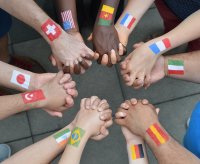Passport to Tolerance
Exploring and celebrating the different cultures that make up America is a great way to make schools safe and welcoming for all.
Your content has been saved!
Go to My Saved Content.Crimes against people of color continue to appear in the news, and the ugly truth is that the number of hate crimes in large cities increased for four straight years since 2014, according to the FBI. Hate, racism, and prejudice can take a toll, a psychological toll, on those who face these attitudes, and they impact all of us in schools.
The good news is that educators can do something about this in our schools. If there’s any place in America where we can create change for a better society, it’s our schools—no other institution has their reach as every member of society (aside from kids who are homeschooled) is educated through schools. So what are things that we can do to combat racial prejudice and promote understanding in a multicultural society?
First we must build our own capacity to understand and empathize.
Getting to Know the World Outside the U.S.
Most of us educators can’t afford to just pack our bags and book a trip abroad any time we want, but we can experience the world without going too far from home. Why is this important? Such experience helps us develop a worldview that is the foundation of empathy for those who are different from us.
The chef and travel writer Anthony Bourdain once said, “If I’m an advocate for anything, it is to move. Across the ocean, or simply across the river. Walk in someone else’s shoes or at least eat their food. It’s a plus for everybody.”
We can explore different cultures through art, food, and entertainment. When we visit a Mexican or African art museum, we learn about the art and culture of a people and understand a little more about their history and hopes for the future. When we make reservations for dinner at a Vietnamese restaurant, we open ourselves up to experience a different cuisine and culture, one that has been influenced not only by climate but by war and colonialism (the famous Vietnamese banh mi sandwich would not exist without the French baguette).
When we watch a foreign movie or read an international book, we can learn about different viewpoints, explore different societies and settings, and meet characters who are foreign to us. And that’s the point. We are opening ourselves up to different perspectives that can help us understand the world a little better. In turn, we may have greater insight into what makes our diverse school communities so special.
Getting to Know Our Students’ World
My school is located in a small, diverse pocket in a larger, more homogenous suburban area near Sacramento, California. Most of the school staff don’t live in the neighborhood around our school. However, we feel it’s important that we know and understand our families deeply, so we plan events in the neighborhood—school meetings in the community library, fundraisers at local restaurants.
What if we extend that idea even further? Shop the local businesses. Go to the barbershop. Go to the grocery store. In the same way we broaden our perspectives when exploring the world—or exploring other cultures while staying close to home—we build our capacity to empathize when we explore the communities around our schools.
Even if we don’t meet any students or parents in our neighborhood travels, our experiences in the community help shape our knowledge of who we’re serving. And if by chance we do meet the people from our school community, we may start to build connections and feelings of trust that will only add value to the work we do in school.
Bringing the World Into Our Schools
We must make it clear to our communities that we value diversity and that everyone is welcome in our schools and districts. Saying that is not enough—we need to do things. We can bring in parents of color for Career Day. We can read diverse children’s books as an entire school, sharing these stories with parents to read at home. This month, for example, our school is reading Jacqueline Woodson’s The Day You Begin, which is about feeling like an outsider.
For the last five years, our school has partnered with neighboring schools to host a World Fair event every spring. Our vision is to highlight and celebrate all the diverse cultures that are in our schools. Families volunteer to run a booth in which they share cultural artifacts and food samples. From Russia to Mexico, we have nearly 30 countries represented every year.
Every student “traveler” is given a booklet for the event, a passport to be stamped as they visit the different countries at the World Fair. Throughout the evening, the main stage may feature performances from a student baile folklórico dance group or a Ukrainian bandura quartet.
The World Fair is a wonderful community event that tells our families that they are valued and that they’re an important part of the school community. But even in schools with little diversity, World Fairs can be opportunities for kids and parents to study and explore other cultures.
We don’t have a chance of changing the world for the better if we don’t explore and celebrate our differences in our schools. In fact, doing this work in schools gives our next generation a chance of living in a more respectful and tolerant society. We owe it to our communities to do a better job at promoting these values. We owe it to ourselves, and most importantly to our kids.
